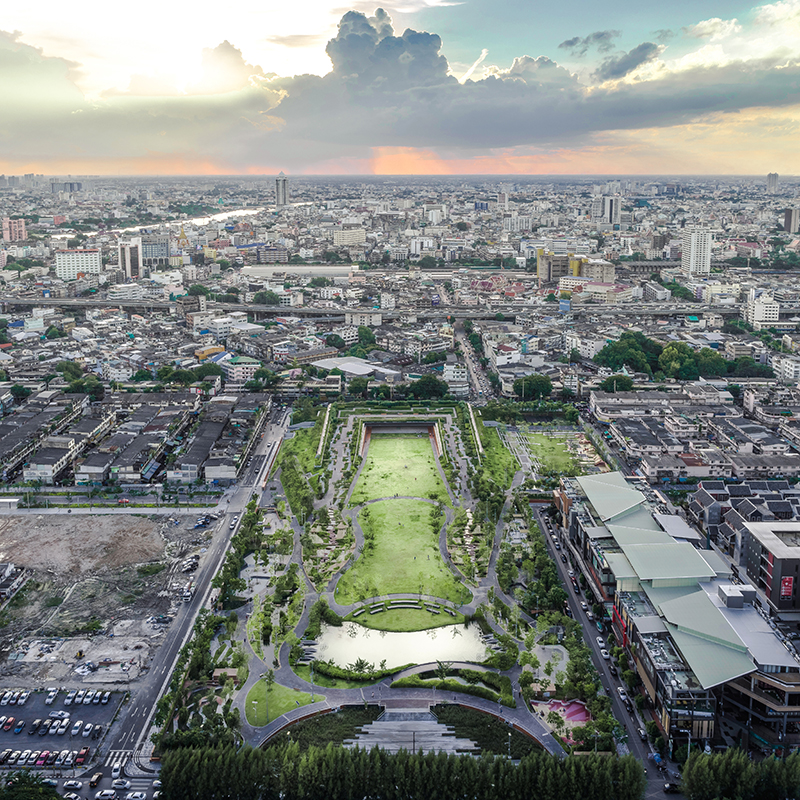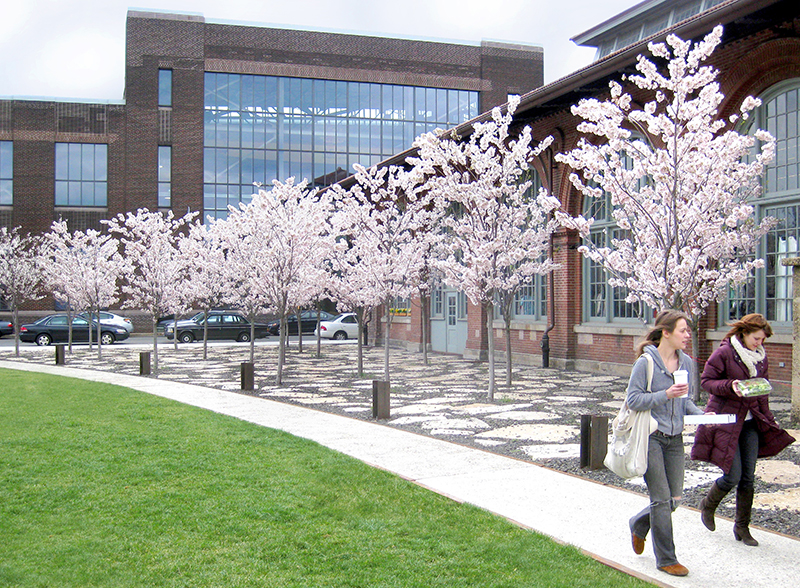News
Interview with Meg Calkins, FASLA
 Meg Calkins, FASLA
Meg Calkins, FASLA
Over the past few decades, how much progress have we made towards achieving sustainable landscapes? What practices promoted through the
Sustainable SITES Initiative® (SITES®) have landscape architects now widely adopted? What low-impact material alternatives do landscape architects now widely use?
In general, we have made strong progress toward sustainable landscapes in some areas. Green infrastructure -- including bioretention, bioswales, rain gardens, even green roofs -- are now pretty widely used, especially in urban environments. Their performance and cost benefits are well-documented.
Landscape architects are getting a handle on how to employ them in a functional and artful way. Landscape architects are also starting to speak the language of civil engineers and doing great collaborations in the area of stormwater management. This whole area of SITES and sustainable site design has been really successful.
 ASLA 2019 Professional General Design Honor Award. Chulalongkorn University Centenary Park, Bangkok, Thailand / LANDPROCESS
ASLA 2019 Professional General Design Honor Award. Chulalongkorn University Centenary Park, Bangkok, Thailand / LANDPROCESSLandscape architects are also designing with native plants and plant communities in mind, and many are avoiding invasive plants. If only we could get the nursery industry to not stock invasive plants, we would be OK. But even in urban settings, landscape architects are conceiving of plant communities as habitat as well as having aesthetic value.
Where are the major gaps? Where does progress need to happen the most?
Use of materials with reduced environmental and health impacts are lagging behind. This is because clear and comparable information about the carbon footprint, resource use, manufacturing impacts, and toxicity of materials and products is not widely available.
Information transparency is perhaps the biggest challenge when trying to reduce the environmental and human health impacts of materials and products. LEED, SITES, and the Living Building Challenge offer credits encouraging information transparency, but these credits are still among the least achieved.
Product manufacturers do not provide information on embodied carbon, resource use and waste, energy and water use, and toxicity impacts. Human health impacts may be the most challenging to identify given many manufacturers claim the constituents of their products are proprietary and therefore will not release information on the types of chemicals used or produced and their quantities.
The habitat and cultural impacts of raw material extraction are often an out of sight out of mind issue. For example, we don’t see the impacts of harvesting tropical hardwood lumber from the Amazon, so it doesn’t seem so problematic to use it. We don’t see the ecosystem decline after the removal of the keystone species tree that is cut to make tropical hardwood lumber. We don’t hear about the murders of indigenous people to intimidate them to leave their protected land so tropical hardwoods can be harvested. And we don’t know that there is a 78 percent chance that the tropical hardwood we are using was harvested illegally (Greenpeace 2014).
Through Climate Positive Design, Pamela Conrad, ASLA, has devised a comprehensive approach for designing and constructing landscapes so they sequester more carbon than they emit over their lifespans, transforming them into net carbon sinks. Through her design toolkit, she recommends swapping carbon-intensive materials with lower-carbon options and planting more greenhouse gas-absorbing trees and shrubs. As you just mentioned, one of the issues you have identified is the lack of third party-verified environmental product declarations with publicly accessible data. How can we get full transparency around the environmental impact of landscape products?
First, I want to say that balancing carbon onsite is a critical aim, and Conrad’s design toolkit is wonderful. It's going to have a transformative impact on site design and material and product specifications.
Embodied carbon of materials is a far more accurate indicator of the impact of producing a building material or product than embodied energy. Embodied energy is not as accurate because all energy sources do not have equal impact on the environment. Some will be almost carbon neutral, like wind power, and others, like coal, will have very high embodied carbon and a substantial environmental footprint.
But while carbon considerations are heavily prioritized in decision making in the building fields, they do not tell the whole story. The human health impacts of materials and products, which can be very substantial, tend to fly under the radar.
PVC, a plastic that is used in countless construction products, has lower embodied carbon than some other plastics, but it can be extremely toxic to humans in manufacture, use and disposal, particularly if it is burned or heated to very high temperatures. Designers need to consider these impacts, but the only way they’re going to know about them is for manufacturers to tell us exactly what is in the products and what by products are produced.
Information transparency by product manufacturers is an area that lags behind other sustainability considerations. I did a content analysis study back in 2012 of the websites of all exhibitors at the 2012 ASLA conference. We looked at what kind of information they're providing on the impacts of their materials and products, and the steps they're taking to make them more sustainable. Less than 1 percent provided either life cycle assessment (LCA) or environmental product declarations (EPD).
I'm replicating that study right now, seven years later. I don't have the results yet, but I suspect it's going to be closer to 10 percent providing that kind of information. There is progress being made, but we still not enough information for designers to use to compare similar products.
SITES and LEED have likely had a slight a transformative impact on the information that product manufacturers provide. But the fields of architecture and interior design are ahead of us. If we did a content analysis of their product websites, we would probably find somewhere between 20 and 30 percent provide environmental product declarations.
The main way to address the lack of information is for landscape architects and designers specifying site construction products to talk to product manufacturers and ask for information about the environmental and human health impacts of their products. Telling manufacturers -- "Well, I'm considering using your product but your competitor, Company X, has an environmental product declaration, so I'm going to go with them" -- is only way to make it happen.
Of course, one can earn LEED and SITES credits for companies that offer some material transparency. But I don't know if that's making change as much as designers constantly asking for that information.
Concrete production accounts for around 8 percent of global greenhouse gas emissions. Cement, which is a primary ingredient in traditional concrete, is the second-most used natural resource after water. You have written about the many low-carbon concrete options companies are developing, including carbon-sequestering concrete, concrete that requires lower amounts of energy to produce, and concrete primarily made up of fly ash and other waste products. What will it take to replace the conventional polluting concrete with these new alternatives?
These alternatives are so new that many are not widely available on the market yet. Some are still in development. But of those on the market, only the earliest adopters are specifying them. They're better used in Europe, because many are European technologies.
In the U.S., landscape architects oftentimes don't specify concrete mixes. Landscape architects need to convince the people who do -- the engineers, the contractors and the Departments of Transportation -- to do it.
Contractors are understandably nervous about using new concrete mixes and are not easily convinced to change. Durability is such a key consideration in the performance of concrete, and it is still a question with the new low carbon technologies and mixes. It's just going to take time and experimental applications. If the applications are monitored and the data on performance published, adoption of these technologies will happen.
Solidia Technologies’ Solidia cement (low Portland Cement) and Solidia concrete (injected with carbon) was successfully tested in multiple applications by the Federal Highway Administration (FHWA) in east coast locations. This is one way that these technologies can trickle down into the site construction market. If the FHWA or U.S. Department of Transportation believes in it and has it as either a standard or alternative specification, then the contractors in that area are much more likely to want to use that product.
D.I.R.T. Studio artfully integrated recycled concrete, bricks, and rusted metal found onsite at the Urban Outfitters headquarters at the Philadelphia Navy Yard, creating a rich, layered environment that demonstrates sustainable values. Do you see this recycled landscape aesthetic becoming more popular? What trends do you see in the use of recycled materials?
The answer is both yes and no. There's a type of project that can use reclaimed material successfully. Not all clients want that aesthetic and not all project budgets can afford it.
Some projects will never be able to incorporate reclaimed materials because of the budget and bid structure. In a public bid project where the contractor is not onboard until after the bid set is complete, there may be insurmountable obstacles to use of reclaimed materials. It is best if one can design with reclaimed materials in hand, rather than setting out to find them after the bid documents are complete. If you set out to find a nine-by-nine reclaimed cypress post for the pergola that is fully detailed, you're never going to find it. You need to find the material first and then design with it.
Cost can also be an issue. Once located, reclaimed materials sometimes need to be stored for several months until construction. And the material may need work such as removal of nails, cleaning, resurfacing and even regrading.
I don't want to discourage this: if it's a landscape architect can pay this kind of attention to the reclaimed materials, that's great, but it's just not feasible for every project.
 Concrete was broken into pieces and reused as pavers in a garden. ASLA 2014 Professional General Design Honor Award. Urban Outfitters Headquarters at the Philadelphia Navy Yard, Philadelphia, Pennsylvania / D.I.R.T. Studio
Concrete was broken into pieces and reused as pavers in a garden. ASLA 2014 Professional General Design Honor Award. Urban Outfitters Headquarters at the Philadelphia Navy Yard, Philadelphia, Pennsylvania / D.I.R.T. Studio Steel from the site was reused as low walls for planters. ASLA 2014 Professional General Design Honor Award. Urban Outfitters Headquarters at the Philadelphia Navy Yard, Philadelphia, Pennsylvania / D.I.R.T. Studio
Steel from the site was reused as low walls for planters. ASLA 2014 Professional General Design Honor Award. Urban Outfitters Headquarters at the Philadelphia Navy Yard, Philadelphia, Pennsylvania / D.I.R.T. Studio
There has been a growing movement to end the extraction of Ipe and other tropical hardwoods, which is highly destructive to rainforest ecosystems. Landscape architects like yourself and Michael van Valkenburgh, FASLA, have instead promoted the use of native hardwoods like black locust. There are also composite, thermally modified, polymerized, and acetylated wood products. Help us navigate the landscape of tropical hardwood alternatives. How should landscape architects make a decision?
There is absolutely NO reason to use tropical hardwood lumber anymore. There are good alternatives that exist that perform in some cases better than tropical hardwoods and have far lower impacts to ecosystems. Ipe, Cumaru, some of the other tropical hardwoods are keystone or umbrella species in their ecosystems.
Once that one tree is removed, studies show that the forest, plants, and animals for acres around it that depended on that one tree will decline. Within five years that land is usually turned over to grazing land for cattle. Because of this fact, even selective harvesting is not a good practice for rainforest trees.
 Ipe trees bloom in yellow and pink in the Brazilian rainforest / iStockPhoto.com
Ipe trees bloom in yellow and pink in the Brazilian rainforest / iStockPhoto.comThere are also unseen social impacts to using tropical hardwood lumber. Tropical hardwood extraction has devastating social impacts to indigenous communities. Few designers know that since 1985 there have been 1,700 deaths in the Amazon over land disputes that primarily have to do with illegal logging. Also, tropical hardwoods are not a renewable material because it takes 90 to 200 years to grow a comparable tree, but the lumber from that tree is only going to be in use for about 30 years.
There are many alternatives to tropical hardwoods now on the market. Thermally modified wood, acetylated wood, polymerized wood-- all three of those use heat and either steam or acetic anhydride or a polymer cross-linking agent, furfuryl alcohol, to modify the sugars of the wood, so that decay organisms no longer recognize them as food. All three of these lumber treatments are non-toxic. They make the wood more dimensionally stable, harder, and much more competitive with the durability of tropical hardwoods. And they are easier to build with than the extremely dense tropical hardwoods.
Another alternative to tropical hardwoods is fused bamboo, which has been on the market in China for close to ten years. It's a really hard product similar to Ipe, so it needs carbide blades to cut and drill it. It's a very durable product, and unlike, Ipe, uses a clip system that avoids the pre-drilling and screwing necessary for Ipe boards. It is a rapidly renewable product, with rapid growth of the bamboo every three to five years.
Fused bamboo is essentially stripped, carbonized, and impregnated with phenolic resin, which may or may not have some toxicity issues. It does contain formaldehyde, but the jury's still out on that. Anyway, it performs and weathers really well. It's easily oiled and rejuvenated, guaranteed for 10 years in commercial applications and 30 years in residential applications.
And then of course black locust is also a good alternative. It can be challenging to use because black locust trees do not grow straight, so when you cut it into lumber, it tends to want to return to its irregular form. But it is starting to be grown on plantations and should have a straighter habit when farmed. Also, use of shorter lengths can prevent its tendency to warp.
 Black locust planks make up a walkway in an atrium garden. ASLA 2006 Professional General Design Honor Award. Small is Beautiful, Millburn, New Jersey. Michael Van Valkenburgh Associates / Elizabeth Felicella
Black locust planks make up a walkway in an atrium garden. ASLA 2006 Professional General Design Honor Award. Small is Beautiful, Millburn, New Jersey. Michael Van Valkenburgh Associates / Elizabeth Felicella Innovative new materials in development include concrete that can absorb air pollution and clean the air, bricks that can be grown, and plants that can be engineered to produce light. What emerging material technologies are you most excited about? Which have the greatest potential to improve our built environment?
I'm the most excited a process called electrically modified cement (EMC) activation. It's essentially a process that modifies the surface of hydraulic waste materials like fly ash and blast furnace slag, or even some natural pozzolans like silica sands and metakaolin.
The process increases the surface area of these particles, creating micro-cracks and dislocations of structure at the nano scale, allowing for greater surface area and greater reactivity with respect to the processes of cement. It's possible to achieve a concrete with 70 percent fly ash and just 30 percent cement. Once this finds its way into the market, it's going to really transform concrete. That said, fly ash is only around as long as we're burning coal. In Europe, for instance, they're burning a whole lot less coal, so fly ash is not nearly as prevalent as it is in the U.S. anymore.
The other thing I'm excited about is recycled plastic aggregate concrete (RPAC), which is in the testing and case study application phase. There's a whole lot of waste plastic in this world and if we can find a way to use it instead of non-renewable virgin aggregates, we should. The technology is still in the research phase, but preliminary results of RPAC as fine aggregate show an increased flexural strength, tensile strength, and density. There is so much on the horizon to improve the environmental and human health footprint of concrete.
Meg Calkins, FASLA, is the department head and professor of landscape architecture at North Carolina State University. She is a contributing editor to Landscape Architecture Magazine, a founding member of the Sustainable SITES Initiative® (SITES®), and author of Materials for Sustainable Sites: A Complete Guide to the Selection, Evaluation and Use of Sustainable Construction Materials and The Sustainable Sites Handbook: A Complete Guide to the Principles, Strategies and Best Practices for Sustainable Landscapes.
Interview conducted by Jared Green at the ASLA 2019 Conference on Landscape Architecture in San Diego.